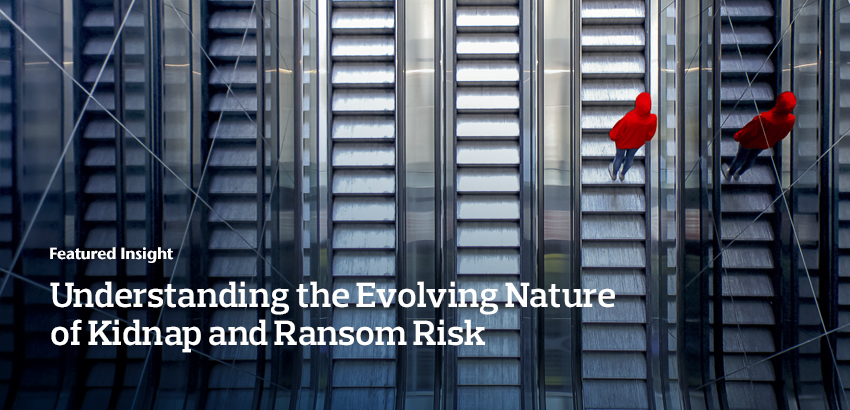Aon | Professional Services Practice
Understanding the Evolving Nature of Kidnap and Ransom Risk
Release Date: February 2023 Matt Boynton, Edward Johnson and Nicola Willison from the Kidnap, Extortion and Threat Response Team for Control Risks discuss the evolving nature of kidnap and ransom risk and provide useful tips for loss prevention with Cara LaTorre from the Financial Services Group at Aon.
In Control Risks’ experience, what are the most challenging aspects of kidnap and other complex extortive events?
Matt Boynton: Each kidnap and ransom event has the potential to become the most challenging crisis a client will face. Myriad factors can combine to challenge executives, crisis managers and their teams and, perhaps the most vulnerable and exposed clients, individuals, families and other victim stakeholders who may be facing a kidnap or other complex extortive event with no preparation or experience.
Whether it is the first time a family is faced with a kidnapped loved one or a CEO supported by a team of seasoned colleagues, the complex and personal nature of extortion-based crises means that each case is unique.
Having to conduct a negotiation under duress, when life hangs in the balance, places unimaginable pressure on a communicator who is often closely related to the victim. Added to the stress of the incident itself is a range of other demands on time and attention:
- Responding to and in some cases working alongside government authorities
- Ensuring that all relevant and required parties are kept informed
- Fielding media inquiries
- Protecting shareholder value
- Appropriately updating employees or family members who have a vested interest in the victim’s safety
- Responding to regulators and customers about the scale and impact of a data loss
- Continuing the business
All these dynamic facets combine in different and unique ways, potentially resulting in the most difficult crisis you may ever face.
The value of having experienced, dedicated specialists alongside you to bring calm, make sense of the inevitable chaos and objectively advise effective solutions to resolve the incident safely and successfully cannot be overstated. That is our mission at Control Risks.
What is the most common incident that Control Risks has seen over the past few years?
Edward Johnson: Control Risks has responded to more incidents of kidnap than any other peril in recent years. While the first half of 2022 saw a six percent decrease compared to the same period in 2021, case numbers remain consistent with a six-month average for the pre-pandemic period.
In terms of location, Control Risks cases are overwhelmingly concentrated in Latin America and West Africa, which accounted for approximately 87 percent of global kidnap cases for the first half of 2022. While we recorded higher levels of threat and extortion cases in 2020, both risks combined continue to make up most of Control Risks engagements.
Our data shows an increase in both threat and extortion in 2022 and we expect this trend to continue in 2023 despite the resumption of travel and lifting of restrictions which have permitted criminals to return to more lucrative crimes including kidnap. Control Risks has also responded to outlier perils such as missing persons, international problems and detention, representing five percent of our total 2022 engagements.
How have incidents changed since COVID-19?
Edward Johnson: The onset of the COVID-19 pandemic initially saw falling global kidnap rates, however, by the end of the first half of 2020 they rebounded sharply with a 35 percent increase compared to the same period of 2019. While the lifting of travel restrictions and local lockdowns resulting in kidnappers operating more intensively, kidnapping rates stabilized, with the first half of 2021 only recording a two percent increase compared to 2020.
At the start of the pandemic, Control Risks correctly forecasted a rise in extortion, threat and cyber-crime as perpetrators shifted their tactics to adapt to the imposition of lockdowns and reduced international travel. The proliferation of these risks has continued in 2022. While the pandemic compounded the threat posed by special risks to businesses in fragile states impacted by conflict, the deterioration of the global economy in the years since has seen both kidnap and extortion increasing in frequency in more stable economies in Africa and the Americas, a trend we forecast will continue in 2023.
What is the best advice with which to provide a business traveler going to a high-risk location?
Matt Boynton: There’s no replacement for doing one’s homework before travelling to a high-risk environment. Without a fact-based understanding of the types and nature of crime in a given destination, even the most benign environment can pose high risks to uninformed and unsuspecting travelers. Major cities in the most developed economies in the world all have neighborhoods and districts where the most experienced traveler can fall victim to crime if not paying attention, suddenly making the mundane seem high risk.
Taking ownership of your own safety, while receiving support from your employer and/or external safety and security advisors in the form of objective, location-specific information and guidance, is excellent advice. While on the road, staying aware of your surroundings and any real-time changes in the security environment, often referred to as having good situational awareness, is a critical component to avoid becoming a victim of crime. Being well informed and using reliable, reputable sources of information in your travel planning is a sensible approach to keeping you safe on the road and creating the conditions for a successful business (and personal) journey.
What type of preventative training should corporate security consider?
Nicola Willison: Organizations can take a range of measures to fulfil their duty of care. Kidnapping trends and extortive crime scams can evolve rapidly. Without regular monitoring, staff can be left unwitting and exposed. Training to avoid certain extortive scams, like virtual kidnapping, can be achieved across the at-risk workforce through eLearning and information campaigns. Employees travelling to or living in high-risk environments should be enrolled on kidnap prevention and survival training courses. Finally, Incident Management Workshops are a valuable tool designed to prepare crisis management teams to deal with an incident quickly and effectively, thereby maximizing the victim’s chances of a safe and timely release.
What type of individuals do kidnapping organizations target?
Edward Johnson: Organized criminal groups are principally motivated to conduct kidnaps for financial benefit, with victim selection shaped by varying factors, depending on their respective local security and operational environments. While local nationals make up the vast majority of victims recorded by Control Risks (currently 96 percent of all victims globally), foreign nationals remain a lucrative target for kidnappers because of their perceived high value to perpetrators.
Foreign nationals, such as business travelers, typically represent more challenging circumstances for kidnappers because of the security practices for high-profile travelers and the strong responses from security services following their kidnap. The exposure of business travelers to kidnap risk varies globally, depending on their sector and the location of their operations as well as the role of the foreign employee. For example, employees in sectors with remote centers of operation, such as extractives, have been targeted in transit to and at work sites by capable, organized armed groups. On the other hand, victims selected on a perception of wealth in urban areas of the Americas face a higher likelihood of express kidnapping.
What type of incidents do you see domestically in the U.S.?
Matt Boynton: The U.S. presents some unique challenges for clients given the highly emotionally charged political and economic environment. We increasingly work on cases in the U.S. where the threat of violence is clear and present. Whether in the workplace, on a campus, or in the home, assessing a threat by assessing the behavior of the threat actor (combined indicators of the threat actor’s credibility, capability, and commitment to carry out the threat) helps inform mitigation strategies and reduce the likelihood of a crisis unfolding.
At a time in the U.S. when many local law-enforcement resources are stretched, assureds have access to our world-class behavioral analytical experts, incorporating proprietary, sophisticated data analytical tools to identify and assess threats and threat actors. This access to hyper-specialized assessment, a blend of human and technological expertise, allows clients to push threats more effectively from the doorstep to the horizon. The resulting extra vision and time to plan or respond creates critical space to avert the crisis in the first instance.
In the U.S., given the current environment, our experience is that engaging external experts to support in-house threat management teams (or fill in the critical gap where no internal resources exist) brings a best-in-class solution to the increasing and very real challenge of managing threats.
Matt Boynton
is the Managing Partner, Confidential Crisis Response, for Control Risks, based in London and Phoenix, Arizona.Edward Johnson
is the Deputy Director of Special Risk Analysis in Control Risks’ London office.Nicola Willison
is the Director of Special Risk Analysis in Control Risks’ London office.Contact
This article can be discussed with Financial Services Group professional Cara LaTorre.

Cara LaTorre
Senior Vice President and KRE Practice Leader
New York
Aon is not a law firm or accounting firm and does not provide legal, financial or tax advice. Any commentary provided is based solely on Aon’s experience as insurance practitioners. We recommend that you consult with your own legal, financial and/or tax advisors on any commentary provided by Aon. The information contained in this article and the statements expressed are of a general nature and are not intended to address the circumstances of any particular individual or entity.
Control Risks is a third party with no affiliation to Aon. Aon disclaims any and all liability, including any express or implied warranties, whether oral or written, for the information in this article and any of Control Risks’ services. Aon has not verified, accepts no responsibility, and makes no representation as to the fitness of Control Risks for the recipient’s intended purpose. While care has been taken in the production of this document, Aon does not warrant, represent or guarantee the accuracy, adequacy, completeness or fitness for any purpose of the document or any part of it and can accept no liability for any loss incurred in any way by any person who may rely on it. Any recipient shall be responsible for the use to which it puts this document. This document has been compiled using information available to us up to its date of publication and is subject to any qualifications made in the document.

